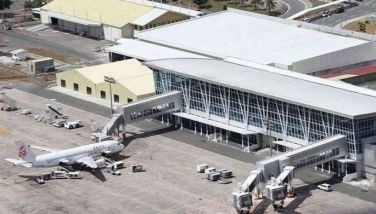Focusing on underemployment

It’s easy for our swaggering politicians hankering for an elected position in both the national and local May 2010 races to put job creation first and foremost in their agenda. But how to get those jobs would be the tricky part.
The easy part would be sharpening the bureaucracy’s mettle to search for jobs abroad while making sure that the employment processing system remains well oiled.
Our labor department is doing a good job of sending out our countrymen to more job vacancies abroad despite the global crisis. Last year, the deployment rate was at 14.38 percent, or an average of 3,377 people a day.
This year, remittances of Filipinos working abroad still managed to grow. During the first nine months of 2009, foreign currency earnings (converted to US dollars) sent back to the country was at an all-time high of $12.8 billion. This represented an increase of 4.21 percent.
Filipinos working abroad are still a source of national pride. We continue to be a preferred choice, and even if national indicators have pointed to a slide in the local education standard, the Pinoy remains an employee of choice in most countries.
OFWs, more so the professionals going abroad of late, are highly respected for their professionalism, generally amiable temperament, adaptability, and “mastery” of the English language. No wonder we have now more than a million Filipinos gainfully employed abroad – and the numbers are still increasing.
Creating jobs locally
The harder part is creating jobs locally. Undeniably, there are still many who are unemployed. The number of people without jobs as of end July this year was at 2.7 million, or a high 7.6 percent of the total population of about 60 million eligible to work.
Underemployment, however, is more serious, reaching 19.8 percent or about 12 million heads as of July 2009. This number of people employed for less than 40 hours a week only means that there is less money being brought home to pay for living expenses.
It is this category that largely affects surveys that ask if respondents feel richer or poorer, and subsequently being translated to the low satisfaction ratings of Filipinos about their government and the bureaucratic leadership. No wonder GMA’s rating is at such low levels.
Unfortunately, underemployed persons are usually those who have the least qualifications for gainful employment. There are undergraduates, some in vocational or diploma courses, but most of them are drop-outs as early as from primary levels. As such, they have very little chances of pursuing meaningful careers.
Most underemployed Filipinos are in the agricultural sector. They are employed on a seasonal basis, i.e., during planting and harvest. They desire to do more work, but there is no work available for them that can pay decent basic wages.
Cycle of poverty
Not surprisingly, many of those belonging in the underemployed sectors are also those being seen as among the poorest of the poor. They likewise have the highest population growth rate. It is a cycle that breeds more people who have the least skills for gainful employment and becomes a source for more poverty-stricken families.
Breaking the cycle of poverty has been a huge program by government over the years, but appears to be in for a tough time given the fact that population growth is outpacing total development efforts, even that which includes non-government assistance.
Accessible education
The lack (or low level) of education is considered one of the biggest problems, but solving this requires more than just free tuition. Children who drop out from school or are not able to attend more than 85 percent of the required school hours usually have to help earn money that will pay for the day’s food.
Parents, on the other hand, who barely reached secondary education levels, are difficult to retrain or bestow with additional skills that will help pull them out from the cycle of poverty.
At the moment, the government’s best effort towards this swelling rank of the poorest of the poor would be to distribute subsidies that could encourage parents to keep their children in school. Some NGOs are known to provide a monthly subsidy for every child that performs reasonably well in school.
Overhaul of education system
For those that are not drawn in the dark hole of poverty, upgrading employment skills continues to be the best remedy. But this will need an overhaul of our current education system.
The problem of deteriorating education standards is being addressed by teacher training and initiatives to keep children in school. But education – or even skills training and upgrading – remains a difficult path for those willing to sacrifice hours and money.
The fact that employers are complaining that they have vacancies but not job takers should be a warning bell for our education bureaucrats to find ways and means to make education accessible to those who want them. Only when we can bring the education or skills level of our underemployed higher can we talk about finding more jobs.
Ateneo San Beda renew rivalry in Champions League
Ateneo Blue Eagles will relive its NCAA days and renew the once seething rivalry with the San Beda Red Lions in the Final Four of the PCCL 2009 Philippine Collegiate Championship games. The two teams will clash today in the main game scheduled at 4 p.m. at the Ynares Sports Center in Pasig City.
The Blue Eagles knocked out UST Growling Tigers to arrange the showdown with the Red Lions who escaped the upset-conscious Mapua Cardinals in the round of eight.
Also playing today at 2 p.m. are the NCAA champion San Sebastian Recoletos Golden Stags, who is gearing for a crack at the 2009 Philippine Collegiate Championship but will have to overcome the strong challenge of UAAP third placer, FEU Tamaraws.
After a scary win over the gritty University of San Carlos Warriors at Ormoc City, the Golden Stags went full charge and eliminated NCAA rival Letran Knights in the previous round.
The championship series starts on December 9 at the Ynares Sports Arena, Pasig, with the losers of today’s games battling for 3rd and 4th place and the winners starting their best-of-three games. Game 2 of the championship is on December 10 and Game 3, if necessary, on December 13.
The Round of Four games are covered live by ABS-CBN over Studio 23 with replays at Balls channel in the evening starting at 10:00pm. Sponsors of these games are PLDT, SMART, Molten Balls, Coke, Philippine Star and PAGCOR Sports.
Nominal fees are charged for those watching the games at the Ynares Arena with the net proceeds going to the PCCL-Collegiate Leagues Development Fund. General admission and courtside & ringside seats are available on first-come first-served basis.
To join ongoing contests and for updates on progress of teams as they continue the journey in the 2009 Philippine Collegiate Championship games, visit the official website, www.CollegiateChampionsLeague.net, or send email enquiries to [email protected].
Should you wish to share any insights, write me at Link Edge, 25th Floor, 139 Corporate Center, Valero Street, Salcedo Village, 1227 Makati City. Or e-mail me at [email protected]. For a compilation of previous articles, visit www.BizlinksPhilippines.net.
- Latest
- Trending


























